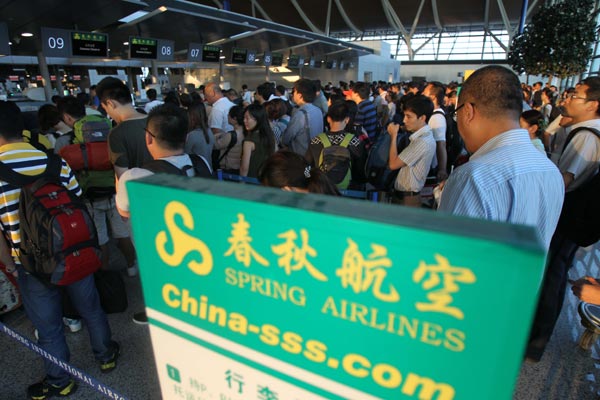

Spring Airlines Co Ltd, the first low-cost carrier in China, took off in 2005 and runs 15 international routes, making up 18 percent of its entire network by the end of 2013. Provided to China Daily
Low-cost airlines soar in China as they diversify their offerings and cater to the changing needs of flyers
Spring Airlines Co Ltd, the first low-cost carrier in China, started trading on the Shanghai Stock Exchange on Wednesday, with its price surging 44 percent to 26.15 yuan ($4.20) on the day.
The carrier issued almost 100 million shares in an initial public offering on Jan 12 at 18.16 yuan per share, much higher than the share price of any of China's four largest carriers. The funds will be used to double its fleet to 100 planes by 2018, it said.
The strong market performance of Spring Airlines reflected investors' confidence in the carrier's low-cost business model, analysts said.
Generally, low-cost airlines offer low fares and limited free services. Unlike the full-service airlines that have battled rising costs in recent years, low-cost carriers have sought innovative ways to cut costs.
The world's first low-cost airline was Southwest Airlines Co in the United States, which has been flying since 1971. Spring Airlines took off in 2006.
The number of Chinese low-cost airlines increased from two to six in 2014, although most of them were formerly full-service carriers.
They accounted for 8 percent of domestic routes in 2014, compared with 0.7 percent in 2006, according to the CAPA Center for Aviation, a global aviation market analysis firm.
The only new low-cost airline in 2014 was 9Air Co Ltd, which ran its first commercial flight on Jan 16. The cheapest seats cost only 9 yuan and they sold out instantly.
Three full-service airlines-China Eastern Airlines Co Ltd's Beijing-based subsidiary known as China United Airlines Co Ltd, China Express Airlines Co Ltd based in Guizhou province and Chengdu Airlines Co Ltd in Sichuan province-adopted the budget model in 2014.
Some airlines, including Capital Air Co Ltd, a Beijing-based subsidiary of HNA Group, and Chongqing Airlines Co Ltd, a subsidiary of China Southern Airlines Co Ltd, have adopted the low-cost model in part by removing first-or business-class cabins and cutting ticket prices, but they don't call themselves budget carriers.
Some other full-service carriers are now looking more closely at the low-cost model.
"Okay Airways is interested in the low-cost model in the regional aviation market, especially in western China," Liu Weining, chief executive officer of Okay Airways Co Ltd, told China Daily.
HNA Group, which is the fourth-largest airline group in China, is taking more radical steps.
The group already has two established low-cost subsidiaries-West Air and Hong Kong Express Airways Ltd. Its two new joint ventures with local governments-Urumqi Airlines Co Ltd and Fuzhou Airlines Co Ltd-also adopt some low-cost strategies.
"In future, all subsidiaries of HNA Aviation Group will work as low-cost carriers and the group plans to only keep Hainan Airlines as a flagship carrier providing full service," said Wang Yingming, executive vice-president of HNA Group.
HNA Group and all the other airlines interested in the low-cost model have been given positive signals from the government.
The Civil Aviation Administration of China released a document to promote the low-cost carriers' development in February 2014.
The measures it announced cover six main areas: fleet growth, route and airport slots applications, approval of startups, service categories and low-cost airport construction.
China's aviation market already has the conditions to develop low-cost carriers, said Zhou Laizhen, deputy director of the CAAC. Some progress has been achieved, although it will take some time for the regulations to be fully effective.
Spring Airlines spent a lot of effort and time cutting unnecessary services, adding fee-based items and providing lower fares. But the process of becoming a budget carrier has become much simpler, due to changing regulations.
It only took one year for 9Air to get operating approval and run its first flight. 9Air signed a 50-plane deal with Boeing Co for B737s in May 2014. That was the largest order so far for a Chinese privately owned airline.
Chinese carriers have to think about transformation of their model, since the world aviation sector has suffered from slow growth in recent years, weighed down by rising staff and fuel costs as well as recession in many countries.
Despite the challenges, Chinese passengers have generally accepted the low-cost model, said Wang Zhijie, senior vice-president of Spring Airlines.
But such carriers still need to educate travelers about the differences between low-cost and full-service airlines, especially when it comes to fees for individual services. And some passengers complain about poor service on budget airlines, although they enjoy the low fares.
It is difficult for Chinese low-cost airlines to cut some costs, including airport fees and fuel costs.
Because of these challenges, experts said that Chinese low-cost carriers still have a long way to go.
"The market room for Chinese low-cost carriers exists, but they will develop robustly rather than booming in a short time," said Li Xiaojin, professor at the Tianjin-based Civil Aviation University of China.
Copyright ©1999-2018
Chinanews.com. All rights reserved.
Reproduction in whole or in part without permission is prohibited.